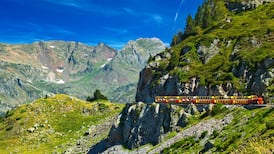I have always had a good sense of direction, probably instilled in me on reluctant walks up hills with my father as a child, where he would point out landmarks, curiously shaped trees and wonky rocks so we could remember our route. “If you get lost, remember the landmarks, turn and go back the way you came.”
This skill evolved in me as a teenager, hanging around the steps of the Central Bank in Dublin, where it became a running joke with pals that tourists knew to ask me for directions.
In my 20s, moving across three continents and seven cities in almost as many years, I always felt safe and secure that I knew where I was going. More recently, as the casual nature of being able to say yes and move continents at the drop of a hat has been replaced with the responsibilities of adulthood, my sense of direction has been channelled into a fascination with Google Maps, spending hours plotting routes and finding places to explore.
So, when invited to the wedding of two best friends in a fairy-tale crumbling castle on the outskirts of Stirling, a town slap-bang in the centre of Scotland, I decided to make a road trip out of it and explore the Highlands for the first time.
READ MORE
There were a few stipulations for the route: we only had eight days and didn’t want to drive every day or for more than four hours at a time. That would mean at least two days in each spot, so this ruled out the northernmost part of Scotland and doing the entire renowned 500 route – the Scottish Route 66 – that circumnavigates the land mass that juts out at the very top of the country – but we would take in a part of it.
With the journey carefully mapped out on a spreadsheet, complete with links of where to stay, eat and what to do, and travel times with pit stops along the way – we are ready to go.
[ Quiet, please! The remarkable power of silence – for our bodies and our mindsOpens in new window ]
The Scottish Highlands conjures up mythical energy – rugged landscapes paired with rich Gaelic history and folklore of ancient battles and clans. The opportunity for wild adventure makes it one of the world’s most popular destinations for travellers looking to escape.
It’s hard not to draw comparisons between our land and that of our Scottish cousins with their welcoming spirit, wild mountains and affinity for whisk (e) y, but the Highlands are so vast that the region offers a sense of total freedom that you don’t experience in Ireland in quite the same way.
Leaving Stirling, feeling almost as crumbly as the castle after the extended three-day wedding celebrations, we go through the village of Callander, often described as the gateway to the Highlands. The postcard-worthy strip is a signal we’re entering something special. Its train station made it a popular destination from the late 1880s for people coming to visit the Highlands, and the legacy of that early tourism boom can be seen in the architecture of the town. Coffees and home-made cakes from the Ancaster Café bought, we mosey on.
The horizon opens up to an expanse across the Rannoch Moor with towering mountains in the distance. It’s like the west of Ireland but everything is bigger. We twist down a narrow road – above us The Three Sisters – three mountains in the Highlands named Bidean nam Bian, Stob Coire nan Lochan and Stob Dearg – hang large overhead. These giant jutting rock formations with the haunting feel of a coven of witches beckon you into the underworld.

Our first stop is Glencoe, a misty, isolated village full of dark history: a massacre took place in this tiny inlet in the late 17th century when the local clan, McDonald, welcomed Scottish government forces into their homes before being slaughtered by them. In more recent history and in a contrast of the obscene and the absurd, the grand Glencoe House was built by a wealthy Scot in the late 18th century complete with artificial lake to remind his Canadian wife of home. Here, the views at breakfast take you out to the misty Pap of Glencoe and the odd wild deer ambling through.
Across the water the island of Skye sits on the periphery, but that’s a trip for another time. We drive in the shadow of Ben Nevis, the highest peak in the United Kingdom, through the town of Fort William and on to a sprawling lunar landscape of peat bogs.

On a sheltered loch in the north west, we come to our next stop. The Torridon is a hotel in an immaculately restored former 18th-century hunting lodge. “Nobody ever comes here,” Queen Victoria said when she visited this part of the country many moons ago. As we sip on afternoon tea, take a bike ride around the edge of the loch and watch as the setting sun transforms the view of the bay, it feels like not much has changed.
Sampling some delicious local whiskeys from the hotel bar’s selection of more than 350 malts, we meet a couple from Oklahoma City, one a pro-golfer exploring a move to Scotland, and both looking to get lost for a while.
From Torridon, we drive northeast, taking in the bottom section of the 500 route. This is one of the most popular scenic routes in the world, so prepare to find yourself dodging Porsches recreating Top Gear moments, motorhomes and cavalcades of motorbikes. The slowness of the drive is part of the appeal; we’re not in a rush to get anywhere.
Inverness is a heady combination of outpost at the end of the world meets landing spot for hordes of explorers from across the globe beginning and ending their Highlands adventures. We arrive on a Saturday evening, when the town is coming alive for the weekend with tourists and locals taking to the streets. We walk past a purple-lit karaoke bar with a group of five people dancing in a circle in the dense fog from a smoke machine. We stumble upon the Rajah, the Highlands’ oldest Indian restaurant, for a quick dinner, and get back in the car and drive on.

On a recommendation from our Scottish friends we’ve planned to head south from here, skirting by Lough Ness and towards the Perthshire Highlands in the very heart of the country.
Perthshire feels quaint compared with the wilds of the west. We weave through quiet villages and past ambling rivers. We have a lunch of the freshest mussels in the autumn sun outside The Grand Tully inn near the small town of Pitlochry.
Much like in Ireland, food in Scotland has evolved in the past decade, with the combination of excellent local produce and a new generation of innovative chefs and restaurateurs bringing a fresh energy. Traditional favourites haggis, neeps and tatties still occupy pride of place, alongside contemporary dishes from chefs who are reinventing the cuisine with new flavours and techniques. We don’t have a bad meal once during our journey.

We overhear an Irish accent at a cooking course at Ballintaggart Farm, a farmhouse and cook school in Perthshire, while learning how to debone wild Scottish salmon. Susan Doherty, from Charlestown in Co Mayo, runs Lifestory, an independent homewares shop in Edinburgh, and is overnighting at the farm. We tell her where we have been and our plans for our last day.
“You must come to Edinburgh,” she says, so we ditch the trusty spreadsheet and check into Prestonfield House on the outskirts of town for our last night. We take a pit stop at our new friend’s shop on our way to the airport, pick up some gifts and grab a quick lunch in the city’s up-and-coming neighbourhood of Leith in a delicious spot called Ardfern. It’s the baby sister to the Michelin-lauded The Little Chartroom and a star in its own right.

It’s just a brief snapshot of the magic of this city at the end of our Scottish adventure, but we take it all in and make note of how and when we are going to find our route back.
Rosie Gogan-Keogh is a writer & business owner from Dublin


















